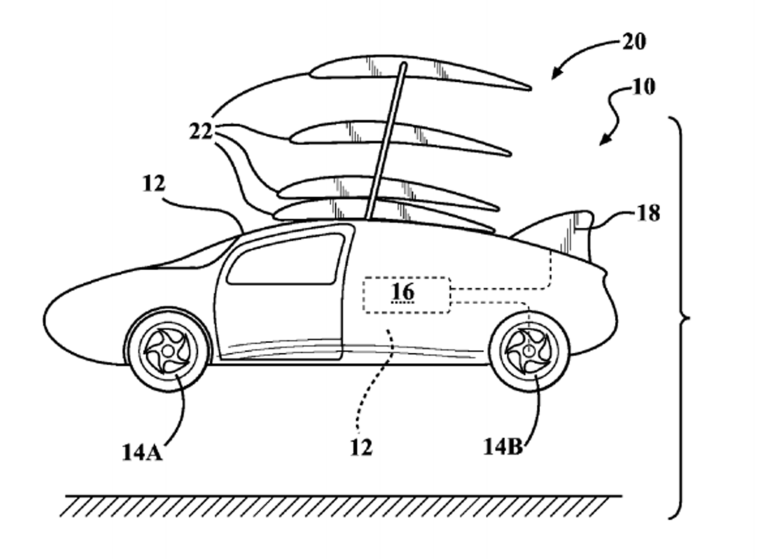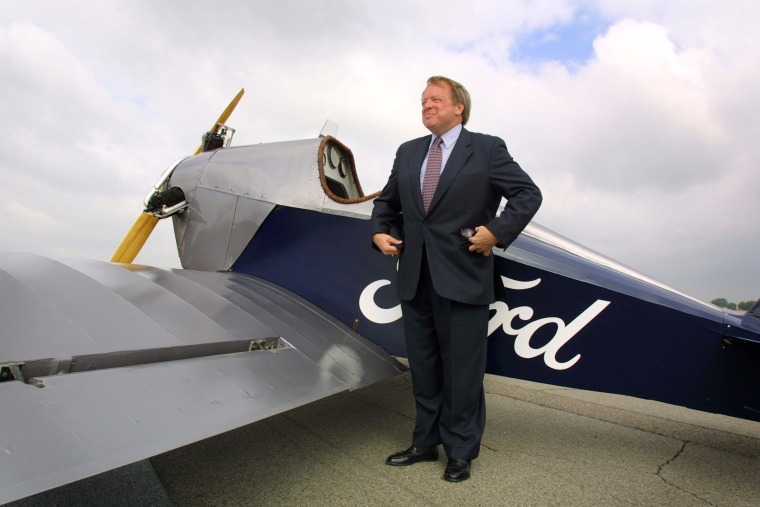Wouldn’t it be great to fly home after a long day’s work — taking to the air rather than getting stuck in a traffic jam?
That’s a fantasy nearly as old as the auto industry itself and now, it seems, one that Japanese giant Toyota Motor Co. may be trying to make a reality.
The Verge first reported Toyota’s flying car ambitions in June, quoting an official with the automaker as saying the company was studying the concept at one of its "most advanced" research and development areas. But the official, Hiroyoshi Yoshiki, said that the plan didn’t involve a full-fledged flying car, but a vehicle that would be able to get "a little bit away" from the road to reduce friction, similar to a hovercraft, according to the report.

Then last week, a patent application that the automaker initially filed with the U.S. Patent Office in March 2014 was discovered. The application describes “an aerocar including a stackable wing and methods for morphing the stackable wing…atop the aerocar,” and includes a schematic showing a wing extending upward from the roof.
The Toyota proposal, patent application 20150246720, doesn’t show how its aerocar would generate the thrust needed to propel it through the air, and given Yoshiki’s comments in June, that might not be the intent. At the time, he declined to elaborate on his initial remark.
Toyota hasn’t said anything more to indicate how serious it is about building a flying car.
The Japanese automaker is hardly the first to explore the concept, however.
Industry pioneer Henry Ford was an early proponent, abandoning the idea only after a fatal crash that killed a friend and chief co-pilot.
And a 1950s-era prototype actually logged some air time relied on detachable wings that could be left behind and stored at the airport.
Related: Teen's Invention Lets You Remotely Chat With Your Dog
The dream hasn’t died in the intervening years. A group of MIT grads has recently begun testing their own flying car concept even as a Defense Department research group is exploring the idea of sending soldiers into battle on a flying motorcycle.
As far as a general use vehicle capable of launching commuters into the air, experts say you can forget “Blade Runner” or “The Jetsons” becoming reality anytime soon. But some proponents believe that at least a few well-heeled motorists could leapfrog traffic in the not-too-distant future.
It’s not clear who first came up with the idea of a vehicle that could fly over or drive on conventional roads, but Ford was certainly an early pioneer. One project he worked on was called the “sky flivver,” a reference to the nickname given his once wildly popular Model T.

Ford eventually abandoned his company’s efforts when a close friend and company test pilot was killed in a crash during an attempt to set a distance record. But as late as 1940, seven years before his death, Ford declared, “Mark my word: a combination airplane and motorcar is coming. You may smile, but it will come.”
Ford Motor Co. produced a 3/8 scale model as late as 1958 of a flying vehicle it dubbed the Volante Tri-Athodyne.
What to do with a flying car’s wings has been one of the biggest stumbling blocks since Ford’s time. But inventor Moulton Taylor got past that in 1949 when he actually got airborne with his Aerocar. It had 30-foot folding, detachable wings that could keep it aloft at up 110 mph, then stored after landing. But only five were built, including the original prototype.
Related: Can the New Toyota Prius Retain Its Spot Atop the Hybrid Heap?
Efforts to let cars take wing seemed to falter for a few decades, but recent developments in lightweight materials, advanced engines and digital computer technology have put wind in the sails of a number of visionary entrepreneurs.
Among projects now underway, the Moller Skycar M400 would use four swiveling turbofans that would allow it to take off and land vertically. The French Xplorair also would permit vertical take-offs. An unmanned version is scheduled to stage a demonstration flight in 2017.
One of the most advanced projects was launched by a group of MIT graduates who have formed the Massachusetts-based Terrafugia. Their prototype, the Transition, has already run a series of manned flights. The company hopes to follow up with an updated production model, the TF-X. Think of it as the Toyota Prius of the air, as it would use a hybrid gas-electric powertrain to give it a range of 500 miles. Their hope is to have the Terafugia TF-X in production by 2021.

DARPA, the research arm of the Defense Department, has been an active proponent of flying vehicles, a concept that could make it easier to get soldiers and gear into battle than with conventional airplanes and helicopters.
The Transition program, launched in 2010, has yet to achieve that goal, but DARPA hasn’t given up.
And the Army Research Lab this summer completed a nine-month test of a hovering motorcycle-like machine that could have been plucked out of an episode of “Star Wars”. The military plans to move ahead on the Hoverbike project, which was developed by the British firm Malloy Aeronautics.
“It can transport troops over difficult terrain and when it's not used in that purpose it can also be used to transport logistics, supplies, and it can operate in both a manned and unmanned asset. It can also operate as a surveillance platform," explained Mark Butkiewicz, an executive with Suvice Engineering, a Maryland firm that will build prototypes of the Hoverbike.
There’s no word on whether a civilian model might follow.
One way or the other, the idea of a flying car just won’t go away. But with indications of Toyota’s interest, for the first time there may be real reason to believe the concept will fly out of a sci-fi movie and into daily reality.
More From The Detroit Bureau
Top Drops on Global Convertible Sales
U.S. Motorists Saved $1.4 Billion on Gas; Prices Heading Below $2?